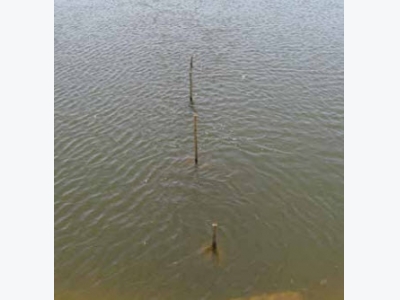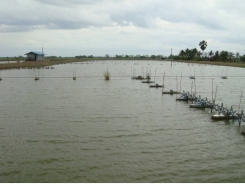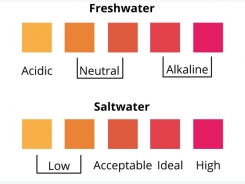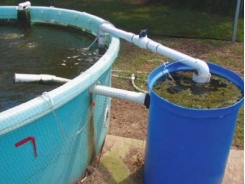Turbidity Removal From Pond Waters

Eliminate sources of turbidity in culture ponds and use coagulants only if the turbidity remains.
Summary:
Troublesome turbidity in aqua-culture pond water often results from clay or fine silt particles that remain suspended due to turbu-lence or excessive sedimentation. Turbidity can also affect ponds that receive manures, chemical fertilizers or feeds. Treatment with coagulants such as alum and gypsum usually clears turbidity from ponds. However, turbid-ity may return because sources of turbidity are not controlled. The best approach is to eliminate sources of turbidity and use alum only if turbidity remains.
Excessive turbidity in ponds caused by suspended soil particles is a frequent occurrence – especially in freshwater aquaculture. The most effective means of preventing “muddy” ponds is to control erosion both in pond watersheds and within ponds.
Where turbid water supplies cannot be avoided, sedimentation reservoirs allow water to be cleared of excessive tur-bidity before it is transferred to ponds. In some cases, however, ponds may remain turbid after all usual measures of control-ling erosion and removing turbidity from inflow have been implemented
Particle Settling
Soil particles settle from water in response to gravity, and larger particles set-tle faster than smaller particles of equal density. The density of mineral soil is more than twice that of organic matter. Thus, mineral matter settles much faster than organic matter of the same particle size.
Troublesome turbidity usually results from clay or fine silt particles. These par-ticles remain in suspension, causing pro-longed turbidity for three basic reasons.
A water body may have enough turbu-lence to prevent fine particles from settling. The resuspension rate of particles may exceed the rate of sedimentation. In addition, colloidal clay settles at an exceedingly slow rate.
Clay particles are negatively charged, and mutual repulsion counteracts the ten-dency of particles to floc together and settle. The presence of cations tends to neutralize negative charges on clay parti-cles and allow them to floc. The capacity of cations to floc clay particles increases with increasing valence.
Monovalent cations (sodium and potassium) are much less effective as floc-culants than divalent cations (calcium and magnesium). Trivalent cations such as aluminum and ferric iron are particularly strong flocculants, but their natural con-centrations in water are very low.
The rate that colloidal clay particles settle from water becomes greater as the total dissolved solids concentration (con-ductivity or salinity) rises. This tendency is much stronger if water hardness (greater calcium and magnesium concen-tration) also increases at higher total dis-solved solids concentrations.
Biological processes also can cause clay particles to settle. Bacteria, phyto-plankton and decaying particles of organic matter have mucilaginous sur-faces to which clay particles stick, allow-ing flocculation to begin. Also, changes in water pH resulting from photosyn-thetic activity or decomposition of organic matter sometimes alter conditions on or around clay particles and allow them to flocculate and settle.
Alkalinity
When waters do not clear after sources of turbidity have been eliminated, the total alkalinity should be tested. If alkalinity is low – less than 30 mg/L – agricultural limestone should be applied at 2,000 to 3,000 kg/ha. Alternatively, lime can be applied, but if the pond has been stocked, lime should not be applied at more than 50 kg/ha to avoid high pH. Repeated doses of lime can be made at weekly intervals.
In ponds that have alkalinity above 40 mg/L, or if liming does not clear turbid-ity, there are two options: Attempt to clear turbidity using fertilizers or treat ponds with coagulants. The common approach is to try fertilizers and use coag-ulants as the last resort

Figure 1. Effects of 25 mg/L alum treatment on total alkalinity, pH and turbidity of pond water
Aquaculture Ponds, Coagulants
Most aquaculture ponds with exces-sive turbidity receive manures, chemical fertilizers or feeds. In manured or fed ponds, one or more applications of urea and triple superphosphate or other nitrogen and phosphorus fertilizers can cause clay particles to settle.
In turbid, fertilized ponds, application of animal manure, grass or other organic material may clear turbidity. Large inputs – 1,000-2,000 kg/ha – of organic matter are needed, and it often is necessary to apply the organic matter in several small applications a few days apart to avoid dis-solved oxygen depletion.
The many possible coagulants include calcium sulfate (gypsum), calcium chloride, aluminum sulfate (alum), aluminum chloride, iron sulfate, iron chloride and certain organic polymers. The two most common coagulants used in aquaculture ponds are gypsum and alum.
Gypsum
Gypsum must be applied in large amounts to remove turbidity. The usual treatment rate is 100-150 mg/L, but tests may be made in jars to ascertain the low-est effective treatment rate. In a 1-ha, 1-m-deep pond, 100 mg/L would require a dose of 1,000 kg/ha.
Gypsum should be spread over the pond surface, and as it dissolves, it will increase the calcium concentration in the water to improve conditions for floccula-tion of suspended particles. The effective treatment rate for calcium chloride is similar to that of gypsum.
Alum
Doses of iron and aluminum com-pounds needed to clear turbidity are lower than those needed for calcium compounds. For example, filter alum usually is effective at concentrations of 20-50 mg/L, and jar tests can ascertain optimum application rates. Alum is potentially dangerous because it is highly acidic, and workers who handle it should wear protective clothing. Alum also depresses total alkalinity concentrations by roughly 0.5 mg/L for each 1.0 mg/L of this coagulant.
In most ponds, alum depresses alka-linity and pH, but after a few days, values return to initial levels (Figure 1). How-ever, alum treatments should not be more than 50% of the total alkalinity concen-tration, and low-alkalinity water should be limed before applying alum.
Alum should be predissolved in water and applied over the entire pond water sur-face on a still day without rainfall. Aerators can be used for a few minutes to mix the alum with pond water, but they should then be turned off to allow the floc to settle.
It is important to apply enough alum initially to cause flocculation, because alum has no residual effect. The active ingredient, aluminum ion, precipitates from water as aluminum hydroxide within a few minutes. If the initial treat-ment is not sufficient, it is lost. Thus, it is prudent to make a jar test to determine the minimum effective treatment rate.
To make the test, make a 10,000 mg/L alum stock solution by dissolving 1 g alum in 100 mL water and fill 10 clear 1-L jars or beakers with the water to be tested. Make a series of alum concentra-tions ranging 5-50 mg/L at 5-mg/L con-centration intervals by adding stock solu-tion (0.5 mL stock solution = 5 mg/L alum) to the jars. Stir vigorously, wait one hour and determine the lowest concentra-tion that caused turbidity to precipitate.
Eliminate Turbidity Sources First
Treatment with coagulants, particu-larly alum, almost always clears turbidity from ponds. However, turbidity may return because sources of turbidity have not been controlled, or the culture species caused bioturbation. Aerator-generated currents cause turbidity, and normal wave and wind action are sufficient to continu-ally resuspend particles and cause turbidity.
The best approach always is to elimi-nate sources of turbidity, and use alum only if turbidity remains.
If the initial alum treatment is not sufficient, it is lost. Thus, it is prudent to make a jar test to determine the minimum effective treatment rate.
Related news
Tools

Phối trộn thức ăn chăn nuôi

Pha dung dịch thủy canh

Định mức cho tôm ăn

Phối trộn phân bón NPK

Xác định tỷ lệ tôm sống

Chuyển đổi đơn vị phân bón

Xác định công suất sục khí

Chuyển đổi đơn vị tôm

Tính diện tích nhà kính

Tính thể tích ao




 Erosion, Sedimentation in Earthen Aquaculture Ponds
Erosion, Sedimentation in Earthen Aquaculture Ponds  Simple Settling Chambers Aid Solids Management In Biofloc…
Simple Settling Chambers Aid Solids Management In Biofloc…